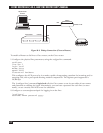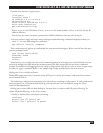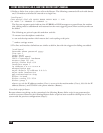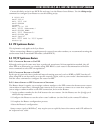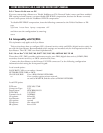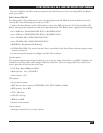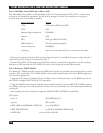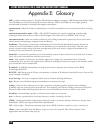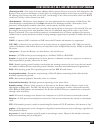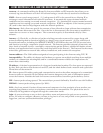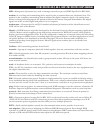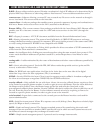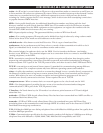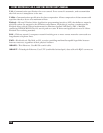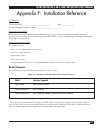
ASYNC ROUTER AR-P, AR-5, AND SYNC ROUTER USER’S MANUAL
120
Appendix E: Glossary
ARP—address resolution protocol. Provides IP-to-Ethernet address mapping. ARP dynamically binds a high-
level IP address to a low-level physical hardware address. ARP is used only across a single physical
network and is limited to networks that support broadcasts.
asynchronous—Method of data communication in which transmission is not synchronized by a clocking
signal.
asynchronous transfer mode (ATM)—The SONET standard for a packet-switching transfer-mode
technique which uses packets (cells) of fixed lengths. Also referred to as “BISDN” and “cell ray.”
auto-answer mode—After successful verification of a calling workstation’s password, client enters auto-
answer mode anticipating a response from the Router.
backbone—The primary connectivity mechanism of a hierarchically distributed system. All systems
connected to an intermediate system on the backbone are connected to each other. This does not
prevent systems from setting up private arrangements with each other to bypass the backbone for
reasons of cost, performance, or security.
back-end—A system that provides services for another system is often referred to as a back-end. In many
cases, the term is synonymous with the term “server.”
baud—The number of times per second the signal can change on a transmission line. Typically,
transmission lines use only two signal states, effectively making the baud rate equal to the number of bits
per second that can be transferred.
B channel—A 64-Kbps information-carrying channel that comprises one element of the ISDN
technology definition.
BOOTP—BOOTstrap protocol. Allows a workstation to obtain its IP address dynamically from a host or file
server instead of statically.
boot, boot up—To start a computer. Often used to indicate starting the Router.
bps—Bits per second. Modem signal transmissions are measured in bps.
bridge—A device that connects two or more networks and passes packets between them. Bridges
normally operate at the physical network level. For example, an Ethernet bridge connects two physical
Ethernet cables and forwards packets that are not locally addresses from one cable to the other.
broadcast—Transmitting a packet to all connected nodes on a network.
byte—A binary representation of a data character, usually consisting of 8 bits.
CHAP—Challenge-handshake authentication protocol is used to verify the identity of the peer using a 3-way
handshake. This is done upon initial link establishment.
CO—Central office. The phone-company entity that a WAN interface (modem or sync) connects to.
client—A user who dials into the Router to get access to the network. The client software is the
application that facilitates this process.



